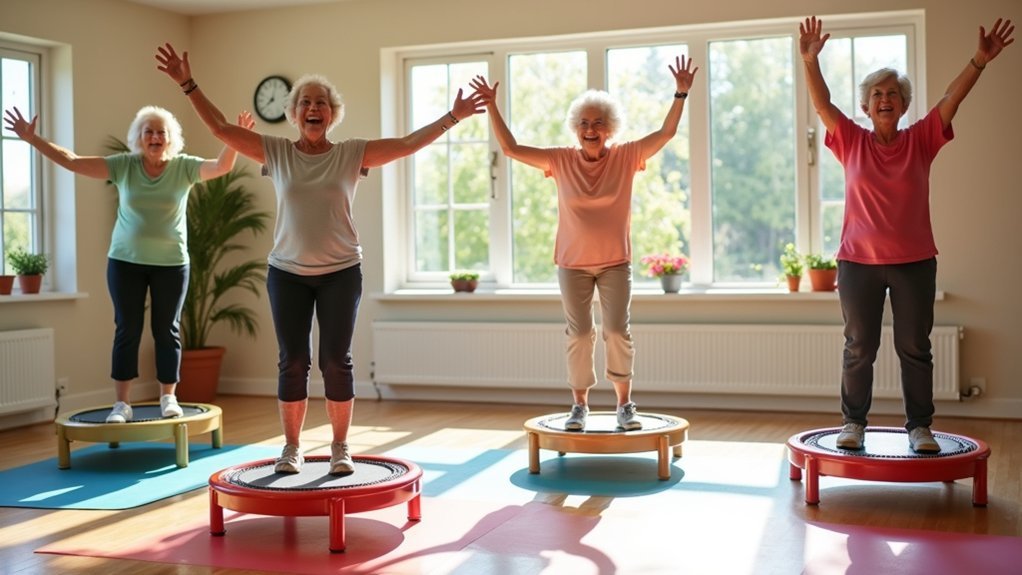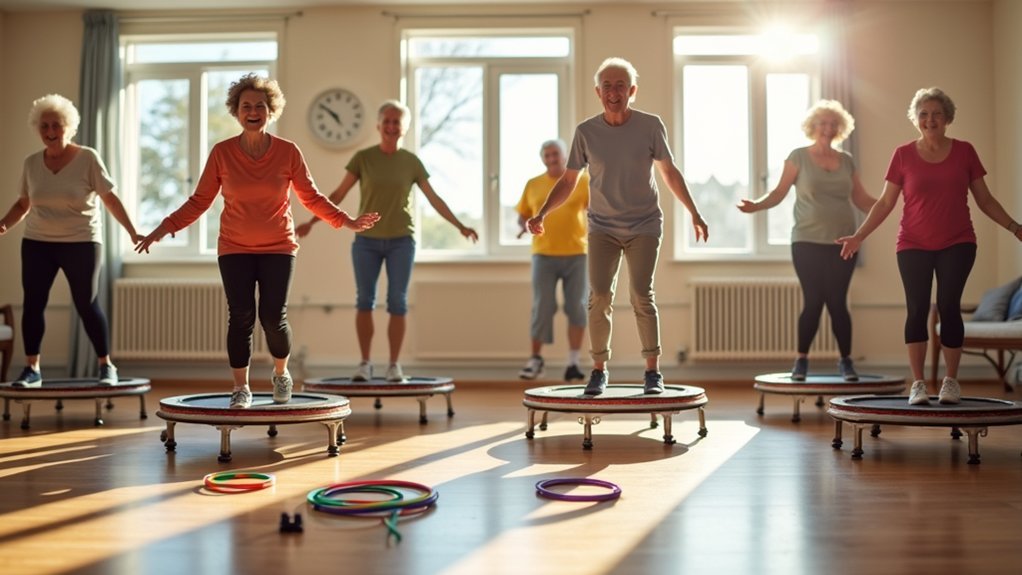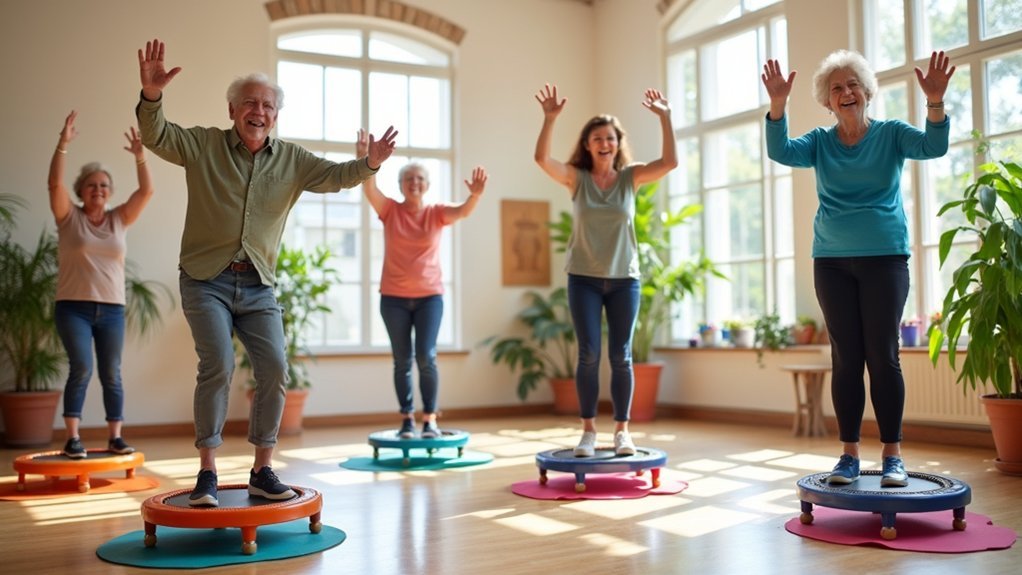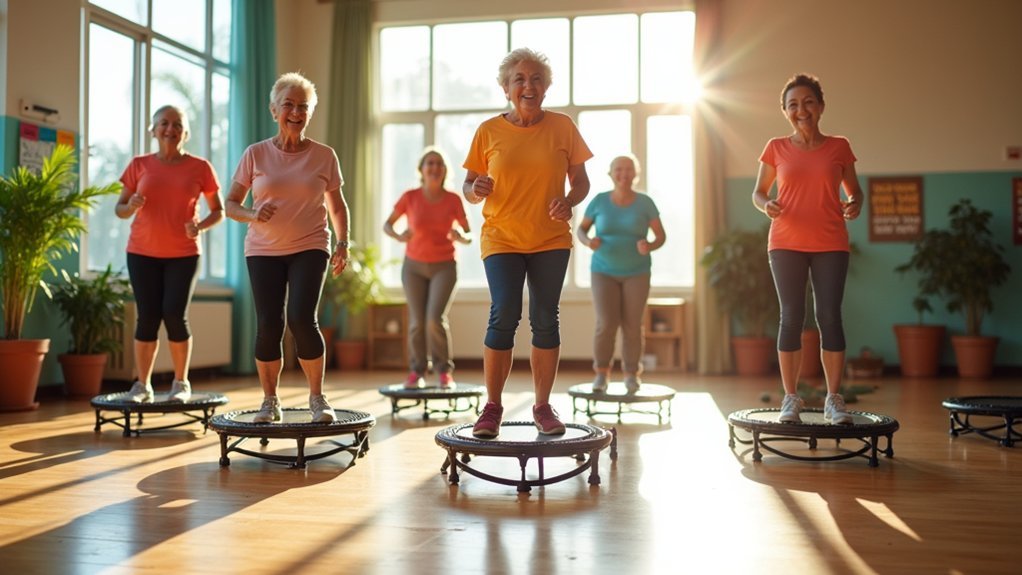Seniors can boost stamina on mini-rebounders through daily five-minute gentle bounces, gradually adding one minute weekly until reaching 20-minute sessions. Try alternating low-intensity bounces with recovery periods, incorporate upper body movements, and engage your core while bouncing. Consider seated options for low-energy days, bounce rhythmically to music, exercise with a partner for accountability, and track your heart rate and bounce duration. These gentle rebounding techniques offer effective cardiovascular benefits without stressing your joints.
Daily Five-Minute Bounce Routines for Building Endurance

Five minutes is all you need to transform your stamina as a senior.
Begin with gentle up-and-down movements on your mini-rebounder, engaging your core muscles while allowing your body to adapt to this low-impact exercise.
Maximize your five-minute bounce by incorporating variety—try health bounces, march in place, or take side-to-side steps to work different muscle groups simultaneously.
These simple modifications deliver extensive health benefits beyond what you might expect from such brief sessions.
With consistent practice, you’ll notice significant improvements in balance, coordination, and energy levels, making everyday activities more manageable.
To build endurance systematically, increase your bouncing time by just one minute weekly, working toward a 20-minute routine.
Daily rebounding also stimulates circulation and metabolism, enhancing your overall physical well-being.
Alternating Low-Intensity and Recovery Bounces
While developing stamina requires consistency, it’s the rhythm of effort and rest that truly strengthens your cardiovascular system. By alternating between low-intensity bouncing and gentle recovery periods, you’ll maintain a steady heart rate without excessive fatigue.
Begin with 1-2 minutes of low impact bouncing with your core engaged, then shift to 30 seconds of gentle health bounce recovery. This pattern allows your breathing and heart rate to stabilize while still keeping your body in motion. As your endurance improves, gradually extend these intervals.
Start with short bouncing intervals followed by gentle recovery periods, then gradually increase duration as your stamina builds.
This structured approach doesn’t just build stamina—it helps improve your balance and coordination, reducing fall risks.
Over time, you’ll notice enhanced muscle tone and metabolic function, making this alternating method an efficient way to boost overall fitness without overexertion.
Gradual Progression: Adding One Minute Weekly

When commencing your rebounding journey, patience becomes your greatest ally. Start with just 5 minutes of daily bouncing, allowing your body to acclimate to this new exercise form.
Each week, add one minute to your rebounding routine, creating an incremental pathway toward improved stamina without overwhelming your system. This consistent, gradual approach helps you build endurance while minimizing strain.
By following this method, you’ll work toward the ultimate goal of 20-minute sessions, where cardiovascular benefits considerably increase.
- Feel your confidence soar as you conquer each one-minute milestone
- Experience the satisfaction of tracking your stamina improvements week by week
- Enjoy the simplicity of short, manageable sessions that easily fit into your daily routine
Your body will thank you for this measured, progressive approach.
Upper Body Movements to Enhance Cardiovascular Benefits
To transform your mini-rebounder session into a full-body cardiovascular powerhouse, simply incorporate strategic upper body movements during your bounces.
Try adding arm circles, overhead reaches, or cross-body punches while rebounding to considerably increase your heart rate and improve circulation.
You’ll maximize your mini trampoline workout by including resistance bands, which strengthen your upper body while simultaneously boosting cardiovascular benefits.
Alternating arm raises during your rebounding workout engages core muscles, enhancing stability and overall effectiveness.
Research shows that combining upper and lower body movements creates a more extensive exercise experience, improving both endurance and muscle tone.
Full-body rebounding integrates all muscle groups, maximizing your workout efficiency while enhancing overall fitness results.
These integrated movements elevate your heart rate more effectively than leg-only rebounding, resulting in greater caloric burn and stamina improvements—perfect for seniors looking to enhance their cardiovascular health through enjoyable, low-impact exercise.
Core Engagement Techniques While Rebounding

Activating your core muscles forms the foundation of effective mini-rebounder workouts, especially for seniors seeking stability and balance improvements.
Draw your navel toward your spine with each bounce to protect your lower back while strengthening your abdominal muscles. The health bounce—lifting your heels slightly off the mat while maintaining core tension—offers an effective workout that enhances muscle tone and improves proprioception.
Consistent core engagement while rebounding delivers multiple benefits:
- Experience the confidence that comes from improved balance and reduced fear of falling
- Feel the satisfaction of standing taller as your posture naturally improves
- Enjoy the independence that comes with enhanced stability in everyday movements
With regular practice, you’ll develop a stronger core that supports better spinal alignment, contributing markedly to your overall health and mobility.
Using Handlebar Support for Extended Workout Sessions
While many seniors initially approach mini-rebounders with caution, the addition of handlebars transforms this exercise equipment into a gateway for extended stamina training. You’ll feel more confident exploring various movements on your fitness trampoline when you can steady yourself with sturdy support.
| Exercise Type | Benefits with Handlebar Support |
|---|---|
| Jogging | Maintain balance while building cardiovascular health |
| Side Steps | Safely increase range of motion and endurance |
| Core Twists | Focus on form rather than stability concerns |
With handlebar support, you’re able to extend your sessions without fear of falling, gradually building stamina at your own pace. You’ll naturally improve your posture during rebounding exercises, maximizing core engagement and overall effectiveness. This added security encourages daily consistency—the key ingredient in developing lasting cardiovascular health and endurance.
Rhythmic Bouncing With Music for Stamina Building
Music transforms your mini-rebounder routine from a workout into a rhythmic experience that naturally extends your stamina. When you bounce to the beat, you’ll maintain a consistent heart rate that gradually improves your cardiovascular endurance.
Bounce in harmony with music to transform your rebounder routine into a heart-strengthening rhythm that effortlessly extends your stamina.
This synchronized movement creates a low-impact way to move that’s easier on your joints while still building impressive stamina over time.
- Feel the exhilaration as your body synchronizes with uplifting melodies, pushing you past your usual limits
- Experience the satisfaction of completing longer sessions without noticing the time passing
- Enjoy the confidence boost as your coordination improves with each rhythmic bouncing session
Select music with tempos that match your desired intensity level, allowing you to naturally progress your stamina building as you become more comfortable with rebounding exercises.
Seated Rebounding Options for Lower Stamina Days
On days when your energy feels depleted, seated rebounding offers a perfect way to maintain exercise consistency while protecting vulnerable joints from unnecessary pressure.
You’ll find that gentle bouncing on a mini-rebounder from a chair position provides remarkable stability while still activating your lymphatic system and improving circulation.
These seated exercises can strengthen your core and enhance balance without requiring you to stand, making fitness accessible even during low-stamina periods.
Chair Bouncing Benefits
Seated rebounding offers a perfect solution for seniors experiencing low-energy days or mobility challenges.
Chair bouncing provides cardiovascular benefits while eliminating joint stress through low-impact exercise. You’ll boost your heart rate and strengthen core muscles while remaining comfortably seated, making it ideal for those with limited mobility or reduced stamina.
- Feel the renewed energy as your circulation improves with each gentle bounce, revitalizing your body without exhaustion.
- Experience the joy of movement again as you improve balance and stability, regaining confidence in your daily activities.
- Enjoy the freedom of exercising while watching your favorite shows, making fitness an effortless part of your routine.
This accessible approach to exercise stimulates your lymphatic system, aiding detoxification and gradually building stamina while protecting your joints.
Gentle Stability Techniques
When your energy reserves feel depleted, gentle seated rebounding offers a perfect low-exertion alternative that still delivers impressive benefits. You’ll maintain your exercise routine while minimizing joint strain and maximizing stability.
| Technique | Benefits | Muscles Engaged |
|---|---|---|
| Seated Bouncing | Improves circulation | Lower body stabilizers |
| Arm Circles | Enhances coordination | Upper body/core |
| Gentle Leg Lifts | Builds joint strength | Hip flexors/quads |
On days when standing feels challenging, seated rebounding keeps your healthy aging journey on track. The gentle bouncing activates stabilizer muscles throughout your lower body while promoting cardiovascular health. Try adding synchronized arm movements to increase upper body engagement without overtaxing your system. This modified approach guarantees you’ll continue strengthening your body even during periods of reduced stamina.
Reducing Joint Pressure
Many seniors discover that seated rebounding provides an excellent alternative for maintaining fitness while considerably reducing joint pressure.
You’ll find that using a mini-rebounder from a seated position allows you to engage in low-impact exercise without standing, which minimizes strain on your knees, hips, and ankles. This gentle bouncing motion stimulates circulation while protecting vulnerable joints.
- Experience the freedom of movement without the fear of falling or joint pain
- Enjoy increased energy and liveliness even on days when standing exercise feels overwhelming
- Reclaim your confidence as you gradually build strength at your own pace
Combine seated rebounding with upper body movements to boost stamina thoroughly.
The gentle bouncing helps with lymphatic drainage and metabolism support—all while keeping your workout joint-friendly and accessible regardless of mobility challenges.
Partner Rebounding for Motivation and Accountability
You’ll find that bouncing with a buddy creates a powerful social support system that keeps you coming back to your mini-rebounder day after day.
When you share your rebounding goals with a partner, you’re more likely to stay accountable and push through those moments when motivation wanes.
Partner challenges, like seeing who can maintain proper form the longest or completing synchronized routines, transform ordinary workouts into engaging social experiences that benefit both your physical stamina and emotional well-being.
Social Support System
Although rebounding can be enjoyed as a solo activity, pairing up with a friend or family member greatly enhances the mini-trampoline experience for seniors. Partner rebounding creates accountability that keeps you motivated to stay active when you might otherwise skip a session.
This social interaction extends beyond just exercise—it becomes a meaningful way to connect while improving your health.
- Feel the joy of sharing victories as you both notice improvements in balance, energy, and strength over time
- Gain confidence knowing someone is there to offer support when trying new rebounding movements or techniques
- Experience the powerful motivation that comes from knowing someone is counting on you to show up
When you exercise together, you’re not just improving your physical fitness experience—you’re building relationships that enhance overall wellbeing.
Buddy Challenge Benefits
Pairing up with a partner for mini-rebounder sessions transforms regular exercise into an engaging adventure that keeps both participants accountable.
When you exercise with a buddy, you’re less likely to skip workouts—your partner’s presence provides that extra motivation to show up consistently.
Partner exercises on rebounders allow you to push beyond your comfort zone, achieving greater intensity and stamina gains than you might alone.
You’ll find yourself inspired to try new movements as you learn from each other in a safe, supportive environment.
The friendly competition that emerges during buddy challenges makes workouts more enjoyable while helping you reach shared fitness goals.
Plus, these social interactions boost your mental well-being, combating isolation that some seniors experience while improving your physical health simultaneously.
Tracking Progress: Monitoring Heart Rate and Bounce Duration
Fitness enthusiasts know that measuring progress is key to staying motivated. When you’re rebounding, tracking your heart rate helps guarantee you’re working at 50-70% of your maximum—the sweet spot for cardiovascular benefits without overexertion.
Start by logging your bounce duration, beginning with just 5 minutes daily and gradually working toward 20-minute sessions for ideal stamina building.
Consistency builds endurance—track your daily bouncing progress from 5 minutes to 20 for maximum fitness gains.
- Feel the pride surge when your journal reveals how you’ve increased from 5 to 20 minutes of continuous bouncing
- Experience the confidence that comes from knowing exactly how your heart responds to exercise
- Enjoy the satisfaction of seeing your bounce count per minute increase as your fitness improves
Using a heart rate monitor provides real-time feedback, allowing you to adjust your intensity for the perfect workout.
Frequently Asked Questions
Is Mini Trampoline Good Exercise for Seniors?
Yes, mini trampolines are excellent exercise for seniors. You’ll get low-impact cardiovascular benefits while improving your balance, bone health, and circulation. They’re joint-friendly and enjoyable, making you more likely to exercise consistently.
Does Rebounding Increase Stamina?
Yes, rebounding does increase stamina. You’ll build cardiovascular endurance through consistent low-impact workouts that don’t strain your joints. Just 20 minutes daily can greatly improve your overall energy levels and endurance capacity.
What Is 10 Minutes on a Rebounder Equivalent To?
Ten minutes of rebounding equals a 30-minute brisk walk cardiovascularly. You’ll burn 50-70 calories while enjoying joint-friendly exercise that improves your balance. It’ll boost your metabolism even after you’ve finished bouncing.
How Can Seniors Build Stamina?
You can build stamina through regular walking, swimming, or cycling. Start with short sessions and gradually increase duration. Stay hydrated, maintain proper nutrition, and guarantee adequate rest between workouts to help your body recover.
In Summary
You’ve now discovered how mini-rebounders can transform your senior fitness journey. Start with just five minutes daily and you’ll notice improved stamina within weeks. Don’t forget to engage your core, mix up your routines, and track your progress. Whether you’re bouncing alone or with a partner, you’re building cardiovascular strength safely. Remember, consistency trumps intensity—you’ll boost your endurance while protecting your joints.





Leave a Reply